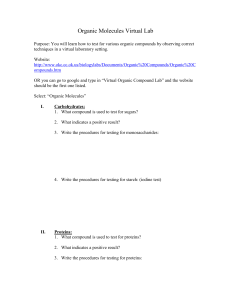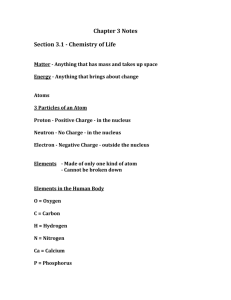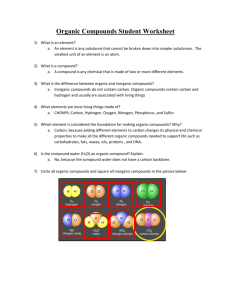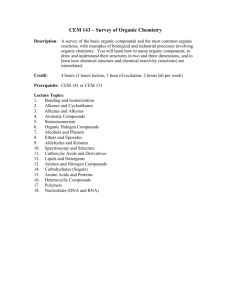UNIT 3 - ORGANIC CHEMISTRY
advertisement
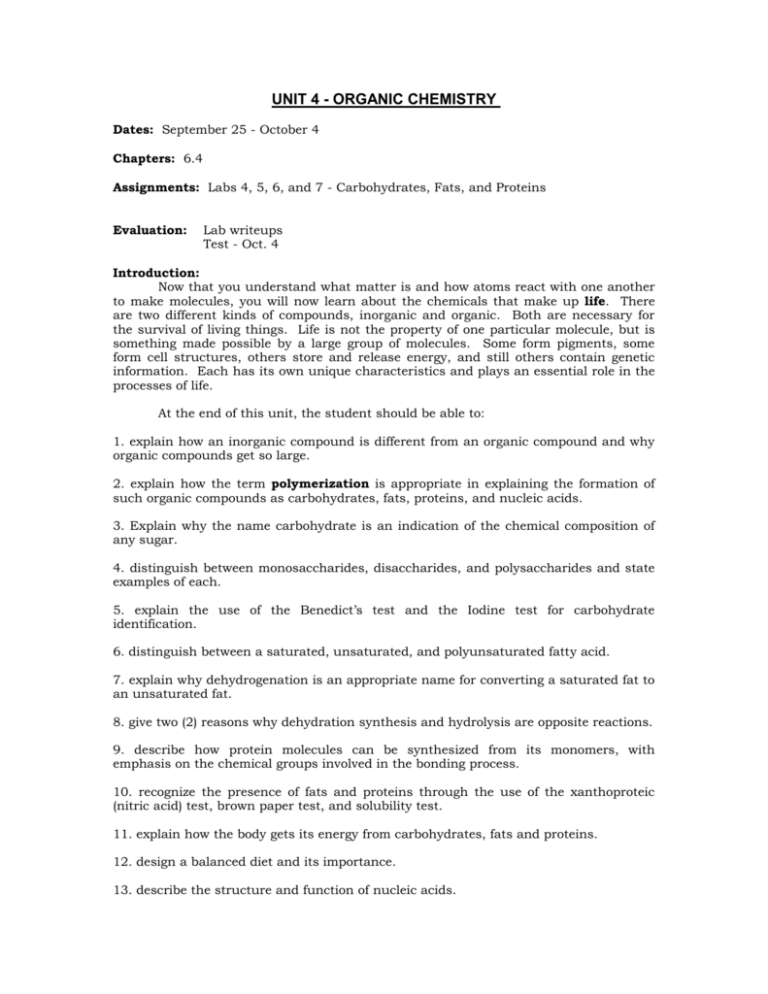
UNIT 4 - ORGANIC CHEMISTRY Dates: September 25 - October 4 Chapters: 6.4 Assignments: Labs 4, 5, 6, and 7 - Carbohydrates, Fats, and Proteins Evaluation: Lab writeups Test - Oct. 4 Introduction: Now that you understand what matter is and how atoms react with one another to make molecules, you will now learn about the chemicals that make up life. There are two different kinds of compounds, inorganic and organic. Both are necessary for the survival of living things. Life is not the property of one particular molecule, but is something made possible by a large group of molecules. Some form pigments, some form cell structures, others store and release energy, and still others contain genetic information. Each has its own unique characteristics and plays an essential role in the processes of life. At the end of this unit, the student should be able to: 1. explain how an inorganic compound is different from an organic compound and why organic compounds get so large. 2. explain how the term polymerization is appropriate in explaining the formation of such organic compounds as carbohydrates, fats, proteins, and nucleic acids. 3. Explain why the name carbohydrate is an indication of the chemical composition of any sugar. 4. distinguish between monosaccharides, disaccharides, and polysaccharides and state examples of each. 5. explain the use of the Benedict’s test and the Iodine test for carbohydrate identification. 6. distinguish between a saturated, unsaturated, and polyunsaturated fatty acid. 7. explain why dehydrogenation is an appropriate name for converting a saturated fat to an unsaturated fat. 8. give two (2) reasons why dehydration synthesis and hydrolysis are opposite reactions. 9. describe how protein molecules can be synthesized from its monomers, with emphasis on the chemical groups involved in the bonding process. 10. recognize the presence of fats and proteins through the use of the xanthoproteic (nitric acid) test, brown paper test, and solubility test. 11. explain how the body gets its energy from carbohydrates, fats and proteins. 12. design a balanced diet and its importance. 13. describe the structure and function of nucleic acids. 14. explain how living things use each organic compound in sustaining their life processes. See if you can match the specific organic compound to a specific life function. Vocabulary: monomer inorganic polysaccharide cholesterol carboxyl group glycerol DNA isomers polymer monosaccharide hydrolysis amino acid amino group dehydration synthesis nutrition organic disaccharide lipid peptide bond fatty acid RNA calorie Extra Credit: 1. “You are what you eat!” Explain the ways in which that statement is correct and the ways it is incorrect. 2. At the yearly convention of chemical compounds, a great debate is raging. The organic compounds represented by the carbohydrates, claim they are the most important compounds in living things. The inorganic compounds, championed by water molecules, claim that life could not exist without them. Write a paper in which you take the side of the organic or the inorganic compounds. Or, as an alternative, you may file a minority report in which you argue both side are incorrect. 3. Knowing what you now do about the 3-dimensional structures of certain organic compounds, explain how the structure of the molecule enables it to carry out its function in living things.


